Author: Qiukaijun
XPeng’s statement “cars below 150,000 RMB cannot be made into smart cars” has caused a great stir. However, XPeng is consistent with his words and deeds. The presale price of its third car is over 160,000 RMB.
On July 17th, the Guangdong-Hong Kong-Macau Auto Show kicked off. XPeng Motors announced at the exhibition that the XPeng P5 officially began pre-sale, launching six models including 460G, 460E, 550G, 550E, 550P, 600P. The new cars are expected to be officially launched in September.
Among the six models, the digits represent the cruising range, and the letters represent the level of intelligence. G represents the standard version, E is equipped with XPILOT 3.0 hardware, and P is equipped with XPILOT 3.5 + dual lidar hardware. XPILOT 3.0 software and XPILOT 3.5 and its upgrade services need to be purchased separately. The presale price of the six models is RMB 160,000-230,000.
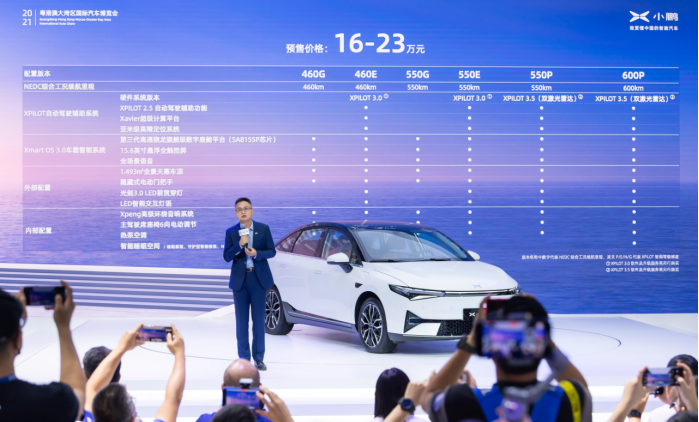
XPeng P5 is truly the third car after XPeng G3 and XPeng P7. Li Pengcheng, vice president of XPeng Motors, said that this car is intended to achieve high sales volume.
Indeed, XPeng Motors has been established for seven years, and its first car has been on the market for nearly three years. It is time to achieve high sales volume.
This is an important point, which means that smart electric cars have moved beyond the initial market of early adopters and are beginning to attack ordinary consumers.
This reminds me of the Master Plan that Musk drew up for Tesla in 2006:
- Build sports cars (Roadster)
- Use that money to build an affordable car (Model S/X)
- Use that money to build an even more affordable car (Model 3/Y)
The logic of this plan is that almost all new technologies are first enjoyed by the rich. On the one hand, R&D costs are high, and on the other hand, supply chains and production have not yet been scaled, so it can only start with expensive cars and use rich people’s money to open up the market and maintain R&D while reducing costs.
Looking at it now, Tesla has basically implemented this plan. The Model 3 has been a huge success and has entered ordinary households. The key point is that the Model 3’s price has been reduced to $30,000 and entered the price range of cars for the average American family, while still being considered a high-end and luxury car in China.Now XPeng Motors is facing the challenge of sales volume, which hopes to be fulfilled by XPeng P5, because it is also a car that is expected to enter the family. However, XPeng Motors first made G3, then went up with P7, and then retreated with P5’s pre-sale price of 160,000 to 230,000 yuan, it seems to have no clear strategy.
Can XPeng P5 help XPeng Motors improve its sales volume? Does XPeng Motors have a Master Plan?
XPeng P5: A Revolutionary Car
The biggest highlight of XPeng P5 is that the high-end version will be equipped with two LIDAR sensors.
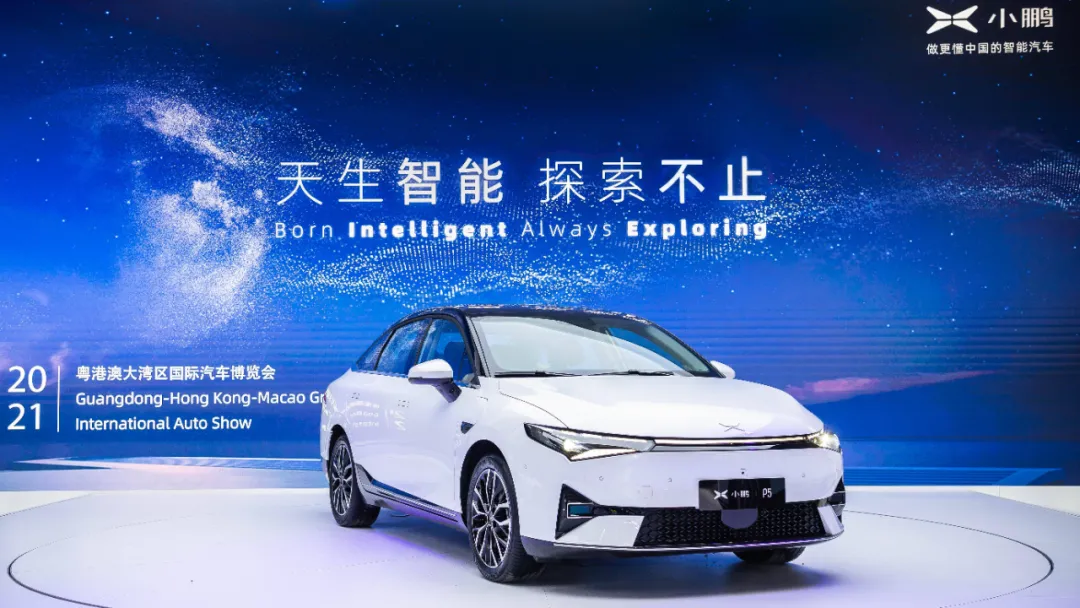
Although the Audi A8 has already been equipped with LIDAR sensors, XPeng Motors has always claimed that it is the first mass-produced car equipped with LIDAR sensors. From the information that was announced now, XPeng P5 is indeed the first car model that makes full use of LIDAR sensors.
XPeng P5’s two versions, 550P and 600P, are equipped with twin LIDAR sensors and other hardware, including 5 millimeter wave radars, 12 ultrasonic sensors, 13 automatic driving cameras, and one sub-meter high-precision positioning unit. The XPilot 3.5 automatic driving assistance system is optional.
With the help of LIDAR sensors, XPeng P5 will become the world’s first intelligent car model with Navigation Guided Pilot function for city roads (NGP), and the application range of NGP will also expand from highways to urban roads, taking steps towards smarter autonomous driving.
The realization of City NGP + Highway NGP basically equals the implementation of L3 level automatic driving in a larger range in many scenarios, where you can drive without holding the wheels.
In this sense, XPeng P5 may be a revolutionary car model. After it, not only other XPeng models will be equipped with LIDAR sensors and have the function of City NGP, but also models from other brands like Jinkoo, NIO, and IM will be equipped with LIDAR sensors and have similar advanced levels of autonomous driving.
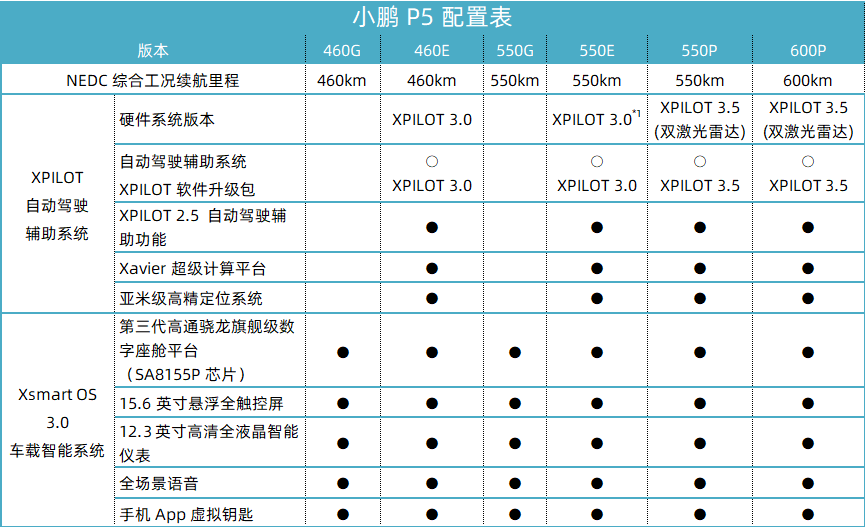
XPeng P5’s 460E/550E models are equipped with XPilot 3.0 hardware, featuring 5 millimeter wave radars, 12 ultrasonic sensors, 13 automatic driving cameras, and one sub-meter high-precision positioning unit.The P5 electric car models from XPeng Motors, including the E and P levels, are both equipped with XPILOT 2.5 software. Customers can upgrade to the corresponding hardware level of XPILOT autonomous driving assistance system by purchasing software services.
The 460G and 550G G-level car models of the XPeng P5 series do not come with any intelligent driving hardware or software. However, they do have Xsmart OS 3.0 in the intelligent cockpit, which is a feature available in all car models of XPeng.
As for XPeng’s smart car threshold, the starting price for XPeng P5’s smart electric cars is about 170,000 to 180,000 yuan.
On July 9th, XPeng released a facelifted G3 i model with a price range of 149,800 to 185,800 yuan. Similarly, the lowest configuration of the G3 i 460N with intelligent driving assistance function is priced at 172,000 yuan.
In other words, all XPeng electric cars are priced over 150,000 yuan, and smart models are priced over 170,000 yuan.
Does this price range affect sales?
Looking at the consumer structure of the Chinese automobile market, less than one-third of the market share for cars priced over 160,000 yuan. XPeng Motors has chosen a relatively small market.
From the current stage, however, this price range positioning is not a problem. XPeng Motors’ so-called “large-scale sales” is not expected to be huge. Taking Tesla and SAIC-GM-Wuling as examples, the best month record for sales was only about 30,000 units.
The penetration rate of intelligent electric vehicles is still very low. It is not so significant considering which underlying base was chosen. If we must choose, according to Musk’s Master Plan logic, high-end cars are more likely to be electrified. In addition, the share of car models priced at over 160,000 yuan is increasing.
The key is still the product.
XPeng Motors officially announced the positioning of the P5 at the Guangdong, Hong Kong, and Macau Auto Show: “Flexible, comfortable and intelligent family sedan.” In this positioning, a major characteristic of traditional family sedans – space – has been further enabled and becomes a “versatile space”.
Although the P5 still looks like a gasoline-to-electric conversion model, it provides a spacious area that can only be realized with an all-electric chassis. The length of the P5 car is 4.8 meters, but it has a wheelbase of 2.768 meters, providing spacious legroom for rear passengers.
Source: China Passenger Car Association (CPCA)
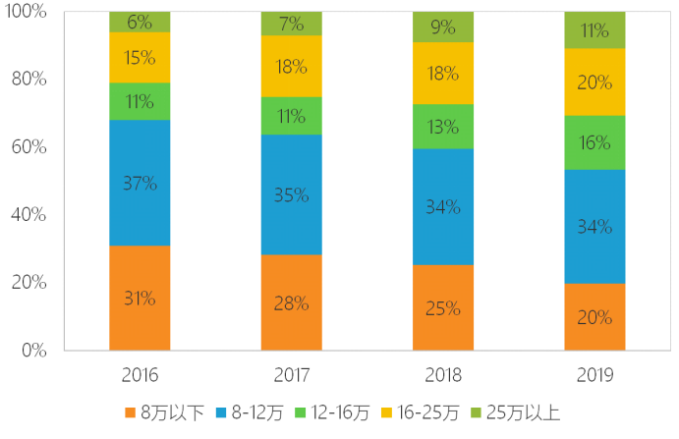
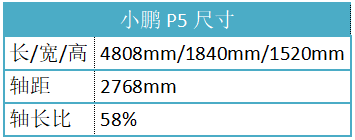
However, the XPeng P5 not only provides a usage area, but also, based on various driving scenarios and leveraging Xsmart OS 3.0 and other intelligent features, transforms it into a smart space.
For example, X-Play mode is provided for entertainment scenarios, X-Sleep mode is provided for sleep scenarios, and X-GO mode is provided for outdoor scenarios, among others.
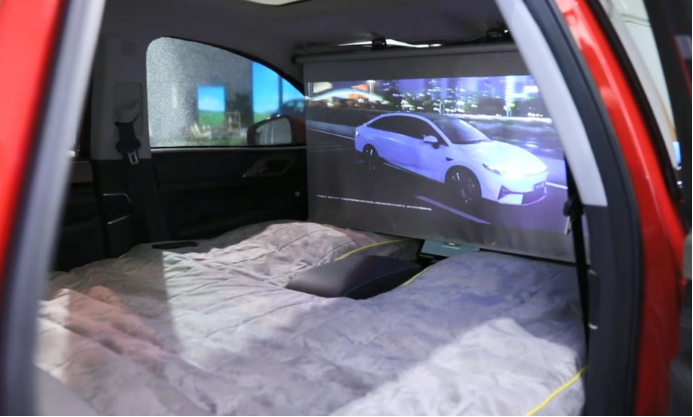
Defining the target users as families is not enough. It is also necessary to further refine the target users through scenarios, and to provide corresponding functions and experiences. This is the fundamental difference between the XPeng P5, which is also a family sedan with a large space, and other family sedans.
As a “Versatile, Comfortable, and Smart Family Sedan,” XPeng adheres to its positioning as “smart” and continues to emphasize its intelligent features. Unlike other sedans that stick to conservative approaches to intelligence due to their family targeting, XPeng shoulders the responsibility of exploration, becoming the first in the industry to incorporate laser radar technology and even challenging functions such as City NGP. This reflects XPeng Motor’s persistence.
What is XPeng Motor’s product definition strategy behind such innovation and persistence?
“Our cars do not have benchmarks,” said Jiang Weizhong, deputy general manager of XPeng Motor’s Product Planning Department, at a media communication meeting several days before the Guangdong-Hong Kong-Macao Auto Show. “We are quite unique in creating a new category: outstanding intelligence combined with the ability to meet family driving needs.”
During the era of the automobile market boom, automakers could make money by developing models through benchmarking methods. However, China’s automobile market has experienced four consecutive declines. Automakers must accurately position their users and create advanced products for them.
On the one hand, although the XPeng P5 is defined as a family sedan and may seem to overlap with many other models, on the other hand, it is a family vehicle tailored for families who love new and trendy technology.
Static analysis shows that a family sedan requires a large space and safety. However, dynamic analysis reveals that more and more internet natives are forming families, and their expectations for family sedans are different.
Under the blessings of intelligent driving and intelligent cabins, the car’s internal space is not just for seating, but also for leisure, entertainment, sleep, and more. Their desire to make cars intelligent is hidden within their hearts, but has not been discovered, and they may not even be aware of it themselves.
At the communication meeting mentioned earlier, some media colleagues said that XPeng P5 should be for families, while others said it should be a pioneer. I say it should be a pioneering family.
Li Pengcheng joked that I was trying to be diplomatic. But I believe that’s exactly what it is.I understand that in the era of intelligent electric vehicles, the formula for defining products is: User + Scenario.
“+ Scenario” does not mean designing all scenarios for the user, but using scenarios to further screen users, achieve precise user differentiation, and capture and predict user needs.
This product methodology may be the Master Plan that XPeng Motors relies on to surpass its peers.
This article is a translation by ChatGPT of a Chinese report from 42HOW. If you have any questions about it, please email bd@42how.com.